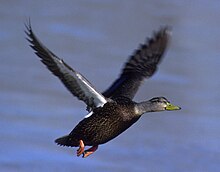
Back Anas rubripes AN بطة سوداء أمريكية Arabic بطه سوداء امريكيه ARZ Makatecip ATJ Черна патица Bulgarian Ànec negrós Catalan Anas rubripes CEB Hwyaden ddu Welsh Dunkelente German Oranĝkrura anaso Esperanto
| American black duck | |
|---|---|

| |
| American black duck in flight | |
| Scientific classification | |
| Domain: | Eukaryota |
| Kingdom: | Animalia |
| Phylum: | Chordata |
| Class: | Aves |
| Order: | Anseriformes |
| Family: | Anatidae |
| Genus: | Anas |
| Species: | A. rubripes
|
| Binomial name | |
| Anas rubripes Brewster, 1902
| |

| |
Breeding Year-round Nonbreeding
| |
| Synonyms | |
|
Anas obscura Gmelin, 1789 | |
The American black duck (Anas rubripes) is a large dabbling duck in the family Anatidae. It was described by William Brewster in 1902. It is the heaviest species in the genus Anas, weighing 720–1,640 g (1.59–3.62 lb) on average and measuring 54–59 cm (21–23 in) in length with an 88–95 cm (35–37 in) wingspan. It somewhat resembles the female and eclipse male mallard in coloration, but has a darker plumage. The male and female are generally similar in appearance, but the male's bill is yellow while the female's is dull green with dark marks on the upper mandible. It is native to eastern North America. During the breeding season, it is usually found in coastal and freshwater wetlands from Saskatchewan to the Atlantic in Canada and the Great Lakes and the Adirondacks in the United States. It is a partially migratory species, mostly wintering in the east-central United States, especially in coastal areas.
It interbreeds regularly and extensively with the mallard, to which it is closely related. The female lays six to fourteen oval eggs, which have smooth shells and come in varied shades of white and buff green. Hatching takes 30 days on average. Incubation usually takes 25 to 26 days, with both sexes sharing duties, although the male usually defends the territory until the female reaches the middle of her incubation period. It takes about six weeks to fledge. Once the eggs hatch, the hen leads the brood to rearing areas with abundant invertebrates and vegetation.
The American black duck is considered to be a species of least concern by the International Union for Conservation of Nature (IUCN), although some populations of the species are in decline. It has long been valued as a game bird. Habitat loss due to drainage, global warming, filling of wetlands due to urbanization and rising sea levels are major reasons for the declining population of the American black duck. The United States Fish and Wildlife Service has been purchasing and managing the habitat of this species in many areas to support the migratory stopover, wintering and breeding populations. The Atlantic Coast Joint Venture also protects habitat through restoration and land acquisition projects, mostly within their wintering and breeding areas.
- ^ BirdLife International (2021). "Anas rubripes". IUCN Red List of Threatened Species. 2021: e.T22680174A137023072. doi:10.2305/IUCN.UK.2021-3.RLTS.T22680174A137023072.en. Retrieved 13 July 2022.
